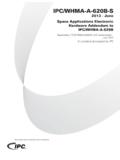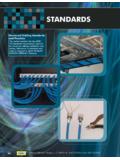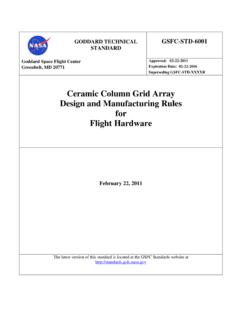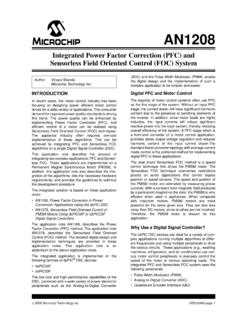Transcription of J-STD-001F E to F redline comparison 27 June 2014
1 Copyright 2014. IPC, Bannockburn, Illinois, USA. All rights reserved under both international and Pan-American copyright conventions. Any copying, scanning or other reproduction of these materials without the prior written consent of the copyright holder is strictly prohibited and constitutes infringement under the Copyright Law of the United States. 1 J-STD- 001f Requirements for Soldered Electrical and Electronic Assemblies redline comparison of revision E to F This comparison is primarily to show technical changes, deletions and additions. Not all editorial changes are shown Copyright 2014. IPC, Bannockburn, Illinois, USA. All rights reserved under both international and Pan-American copyright conventions.
2 Any copying, scanning or other reproduction of these materials without the prior written consent of the copyright holder is strictly prohibited and constitutes infringement under the Copyright Law of the United States. 2 1 GENERAL Scope This standard prescribes practices and requirements for the manufacture of soldered electrical and electronic assemblies. Historically, electronic assembly (soldering) standards contained a more comprehensive tutorial addressing principles and techniques. For a more complete understanding of this document s recommendations and requirements, one may use this document in conjunction with IPC-HDBK-001 and IPC-A-610. and IPC- Purpose This standard describes materials, methods and acceptance criteria for producing soldered electrical and electronic assemblies.
3 The intent of this document is to rely on process control methodology to ensure consistent quality levels during the manufacture of products. It is not the intent of this standard to exclude any procedure for component placement or for applying flux and solder used to make the electrical connection. Classification This standard recognizes that electrical and electronic assemblies are subject to classifications by intended end-item use. Three general end-product classes have been established to reflect differences in producibility, complexity, functional performance requirements, and verification (inspection/test) frequency. It should be recognized that there may be overlaps of equipment between classes.
4 The user (see ) is responsible for defining the product class. The product class should be stated in the procurement documentation package. CLASS 1 General Electronic Products Includes products suitable for applications where the major requirement is function of the completed assembly. CLASS 2 Dedicated Service Electronic Products Includes products where continued performance and extended life is required, and for which uninterrupted service is desired but not critical. Typically the end-use environment would not cause failures. CLASS 3 High Performance/Harsh Environment Electronic Products Includes products where continued high performance or performance-on-demand is critical, equipment downtime cannot be tolerated, end-use environment may be uncommonly harsh, and the equipment must function when required, such as life support or other critical systems.
5 Measurement Units and Applications <No change> Verification of Dimensions <No change> Definition of Requirements The word shall is used in the text of this document wherever there is a requirement for materials, preparation, process control or acceptance of a soldered connection. Where the word shall leads to a hardware defect for at least one class is used in this Standard, the requirements for each class are in brackets next to the shall requirement. N = No requirement has been established for this Class A = Acceptable P = Process Indicator D = Defect Examples: [A1P2D3] is Acceptable Class 1, Process Indicator Class 2 and Defect Class 3 N1D2D3] is Requirement Not Establish Class 1, Defect Classes 2 and 3 [A1A2D3] is Acceptable Classes 1 and 2, Defect Class 3 [D1D2D3] is Defect for all Classes.
6 Copyright 2014. IPC, Bannockburn, Illinois, USA. All rights reserved under both international and Pan-American copyright conventions. Any copying, scanning or other reproduction of these materials without the prior written consent of the copyright holder is strictly prohibited and constitutes infringement under the Copyright Law of the United States. 3 A defect for a Class 1 product means that the characteristic is also a defect for Class 2 and 3. A defect for a Class 2 product means that the characteristic is also a defect for a Class 3 product, but may not be a defect for a Class 1 product where less demanding criteria may apply. The word should reflects recommendations and is used to reflect general industry practices and procedures for guidance only.
7 Line drawings and illustrations are depicted herein to assist in the interpretation of the written requirements of this standard. The text takes precedence over the figures. IPC-HDBK-001, a companion document to this specification, contains valuable explanatory and tutorial information compiled by IPC Technical Committees that is relative to this specification. Although the Handbook is not a part of this specification, when there is confusion over the specification verbiage, the reader is referred to the Handbook for assistance. When the space shuttle symbol appears next to a paragraph it indicates that J-STD-001 FES Space Applications Electronic Hardware Addendum to J-STD-001E contains some different requirements to this The criteria in J-STD-001 FES are not applicable unless the addendum is specifically required by procurement documentation.
8 Hardware Defects and Process Indicators <No change> Material and Process Nonconformance Material and process nonconformance differs from hardware defects or hardware process indicators in that the material/process nonconformance often does not result in an obvious change in the hardware s appearance but can impact the hardware s performance; , contaminated solder, incorrect solder alloy (per drawing/procedure). Hardware found to be produced using either materials or processes that do not conform to the requirements of this standard shall [D1D2D3] be dispositioned when the condition is a defect. classified as defects and dispositioned. This disposition shall [D1D2D3] address the potential effect of the nonconformance on functional capability of the hardware such as reliability and design life (longevity).
9 General Requirements Use of this standard requires agreement on the class to which the product belongs. If the user and manufacturer do not establish and document the acceptance class, the manufacturer may do so. The soldering operations, equipment, and conditions described in this document are based on electrical/electronic circuits designed and fabricated in accordance with the specifications listed in Table 1-1. fabricated in accordance with the specifications listed in Table 1-1. Table 1-1 Design, and Fabrication and Acceptability Specification Board Type Design Specification Fabrication Specification Generic Requirements IPC-2221 IPC-6011 Rigid Printed Boards IPC-2222 IPC-6012 IPC-A-600 Flexible Circuits IPC-2223 IPC-6013 Rigid Flex Board IPC-2223 IPC-6013 Order of Precedence The contract always shall [D1D2D3] take precedence over this standard, referenced standards and drawings.
10 Conflict In the event of conflict between the requirements of this standard and the applicable assembly drawing(s)/documentation, the applicable user approved assembly drawing(s)/documentation govern. Some examples of documentation include the contract, purchase order, technical data package, engineering specification or performance specification. In the event of a conflict between the text of this standard and the applicable documents cited herein, the text of this standard takes precedence. In the event of conflict between the requirements of this standard and an assembly drawing(s)/documentation that has not been user approved, this standard governs.




